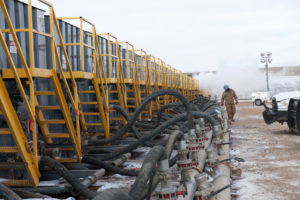
Scientists at Stanford University claim they have devised a way of detecting thousands of faint, previously missed earthquakes triggered by fracking. It’s a claim that could have a profound impact in Oklahoma where thousands of earthquakes have been recorded in the last several years, prompting state regulators to control wastewater injection wells.
Only in one recent case did the Oklahoma Corporation Commission suggest that hydraulic fracturing might have been the cause of small quakes around Yukon. Drilling operations were cut back as much as 50 percent as a result. However, as a spokesman indicated, “What we say is whether there is enough data and evidence to justify a given regulatory response – and on the possibility of frack quakes – we’ve been responded to many events.”
The University of Stanford announced that the new technique can be used to monitor seismic activities at fracking operations to help reduce the likelihood of bigger and potentially damaging earthquakes from occurring.
“These small earthquakes may act like canaries in a coalmine,” said study co-author William Ellsworth, a professor (research) of geophysics at Stanford’s School of Earth, Energy & Environmental Sciences. “When they happen, they should be viewed as cautionary indicators of underground conditions that could lead to larger earthquakes.”
The university study found that as high-pressure fluid is injected underground to crack open rocks and release the natural gas trapped inside, it produces tiny earthquakes that were typically too small to be detected. But now the study can detect them.
“In our study, you can actually see individual earthquakes occurring next to the section of a well that’s being fracked,” said Stanford PhD student Clara Yoon, lead author of the study published in the Journal of Geophysical Research.
Their study cited the October 2010 case in Arkansas where residents near a natural gas field were shaken by a magnitude 4.0 quake followed by two larger aftershocks in February 2011. However, the scientists say the large quakes were caused by wastewater injection wells.
“These were some of the first earthquakes related to shale-gas development to draw national attention,” said Ellsworth. Since then, Oklahoma and north Texas have been shaken by earthquakes.
Here’s how the scientists were able to come up with their new earthquake detecting system. Using an advanced data-mining algorithm, they conducted a retrospective analysis of seismic activity in Arkansas before the magnitude 4 event. The algorithm uses earthquake-pattern recognition to generate detailed records and the analysis tracked seismic events generated at production wells.
As a result, they discovered more than 14,000 small previously unreported quakes. By comparing the timing and location of the tremors with fluid-injection data, the scientists were able to demonstrate that most of the earthquakes were the direct result of fracking operations at 17 of the 53 production wells.





